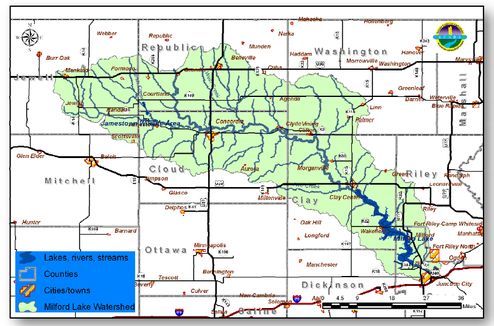Kansas Water Office Partners in Milford Lake Watershed RCPP Project
 Guest article by Matt Unruh, Chief of Planning for the Kansas Water Office
Guest article by Matt Unruh, Chief of Planning for the Kansas Water Office
Throughout the United States, harmful algal blooms (HABs) impact operations for many raw water sources utilized by public water supplies. When HABs are present toxins and taste-and-odor compounds can be produced which can lead to increased treatment costs for water suppliers as well as public health concerns. Milford Lake, a U.S. Army Corps of Engineers reservoir in north-central Kansas near Junction City and Fort Riley, is a prime Kansas example of the impacts HABs can have on drinking water sources as well as collective efforts which are in progress to reduce the magnitude and frequency of HABs occurring.
Phosphorus loading from the Lower Republican River Watershed is one of the contributing factors leading to the formation of HABs in Milford Lake. In an effort to reduce the phosphorus loading entering Milford Lake from the Republican River, the Kansas Water Office (KWO) engaged with a number of partners including the state drinking water program and the Section 319 Nonpoint Source program in the Kansas Department of Health and Environment (KDHE), other state agencies including the Kansas Department of Agriculture – Division of Conservation (KDA-DOC) and the Kansas Department of Wildlife, Parks & Tourism (KDWPT), four public water suppliers including the cities of Topeka, Lawrence, Olathe and Water District No. 1 of Johnson County (WaterOne) which are impacted by releases as they travel downstream of Milford Lake along the Kansas River, as well as agricultural commodity groups and organizations, county conservation districts, and non-profit organizations. 
This partnership team and their direct and/or in-kind contributions were included within a proposal submitted to the US Department of Agriculture’s Natural Resource Conservation Service (NRCS) to establish a Regional Conservation Partnership Program (RCPP) project within the Lower Republican Watershed in Kansas with the objective of reducing phosphorus loading entering Milford Lake by providing additional technical and financial assistance to agricultural producers within the project area. With the project involvement of American Water Works Association (AWWA) member WaterOne, KWO was able to utilize technical assistance provided by the 9b Group through the AWWA Farm Bill Initiative to receive technical support for the development of the pre-proposal and final proposal for the project during 2017. In December 2017, KWO received word from NRCS that the Milford Lake Watershed RCPP Project had been successful in receiving a commitment from NRCS of $2.88 million to be utilized in conjunction with partner team contributions to provide financial and technical assistance within the watershed to increase the adoption of conservation practices through the Environmental Quality Incentives Program (EQIP).
A number of sources of funding will be utilized to provide financial assistance to producers within the Milford Lake watershed through this project. These include Environmental Protection Agency (EPA) Section 319 Nonpoint Source funds administered by KDHE, KDWPT funding, KDA-DOC funding, and State Water Plan funding through the Kansas Water Office. Funding from these sources will be utilized along with NRCS funds to provide sign-up incentive payments for certain practices as well as up to 90% cost share on identified core phosphorus-reducing practices for cropland and livestock-related land use. It is estimated that the first producer sign-up period for this project will take place during the Fall of 2018.
In Kansas as well as nationwide there is a growing trend from public water suppliers in recognizing the value in source water protection-related activities leading to the investment of technical and financial resources to work with agricultural producers to reduce nutrient and sediment runoff. Partnerships such as those in place for the Milford Lake Watershed RCPP Project will play an important role in the successful development and implementation of programs such as the KDHE Drinking Water Protection Program and related programs in other states. Knowing the details of programs available to leverage technical and financial resources such as NRCS RCPP can help to provide vital resources towards source water protection-related activities as well as build partnerships necessary for long-term success.
For more information about this RCPP project, contact Matt Unruh, Chief of Planning, Kansas Water Office, Matt.Unruh@kwo.ks.gov, (785) 296-0861.

